Analysis and Comparison of Energy Efficiency Code Requirements for Buildings: A Morocco–Spain Case Study
Abstract
:1. Introduction
2. Legislative Framework and Energy Policy
2.1. Morocco
2.2. European Union and Spain
3. Materials and Methods
3.1. Preliminaries: Climate Zones
3.2. Methodology
3.3. Reference Residential Building
4. Results
5. Discussion
6. Conclusions
Author Contributions
Funding
Conflicts of Interest
Abbreviations
| BIM | Building information modeling |
| CTE | Código Técnico de la Edificación (Technical Building Code) (Spain) |
| DB-HE | Documento Básico Ahorro de Energía (Basic Energy Saving Requirements) (Spain) |
| GDP | Gross domestic product |
| NDC | Nationally Determined Contributions |
| NES | National Energy Strategy |
| RITE | Reglamento de Instalaciones Térmicas en los Edificios (Regulation of Thermal Installations in Buildings) (Spain) |
| RTCM | Réglementation Thermique de Construction (Thermal Construction Regulation) (Morocco) |
| SCS | Summer climate severity |
| SED | Dynamic energy simulations |
| STD | Dynamic thermal simulations |
| WCS | Winter climate severity |
References
- Mugnier, D. 2019 Annual Report–Feature Article on Solar Integrated Building Facades; Technical Report; IEA Solar Heating and Cooling Programme: Santiago, Chile, 2019. [Google Scholar]
- Peci-López, F.; Ruiz de Adana Santiago, M. Sensitivity study of an opaque ventilated façade in the winter season in different climate zones in Spain. Renew. Energy 2015, 75, 524–533. [Google Scholar] [CrossRef]
- Global Status Report for Buildings and Construction 2019. Technical Report. International Energy Agency. Available online: https://www.iea.org/reports/global-status-report-for-buildings-and-construction-2019 (accessed on 25 September 2020).
- Kyprianou, I.; Serghides, D.; Varo, A.; Gouveia, J.; Kopeva, D.; Murauskaite, L. Energy poverty policies and measures in 5 EU countries: A comparative study. Energy Build. 2019, 196, 46–60. [Google Scholar] [CrossRef]
- Kephalopoulos, S.; Geiss, O.; Barrero-Moreno, J.; D’Agostino, D.; Paci, D. Promoting Healthy and Highly Energy Performing Buildings in the European Union: National Implementation of Related Requirements of the Energy Performance Buildings Directive (2010/31/EU); Technical Report, Science for Policy report 978-92-79-70594-6; Joint Research Centre: Luxemburg, 2017. [Google Scholar]
- Mercader-Moyano, P.; Esquivias, P.M.; Muntean, R. Eco-Efficient Analysis of a Refurbishment Proposal for a Social Housing. Sustainability 2020, 12, 6725. [Google Scholar] [CrossRef]
- Kousksou, T.; Allouhi, A.; Belattar, M.; Jamil, A.; El Rhafiki, T.; Zeraouli, Y. Morocco’s strategy for energy security and low–carbon growth. Energy 2015, 84, 98–105. [Google Scholar] [CrossRef]
- López, R.C.; García-Álvarez-Coque, J.M.; Azcárate, T.G. EU Mediterranean Relations in the Field of Agriculture. 2013. Available online: www.institutdelors.eu/wp-content/uploads/2018/01/mediterraneanagriculture-lopezgarciagarcia-ne-jdi-apr13.pdf (accessed on 25 September 2020).
- Jawad, R.; Aboushady, N.; Mansour, H.A.; Coutts, A.; Bencheikh, N.; Lupieri, S. New Directions in Social Policy in MENA Region. 2018. Available online: https://www.unrisd.org/unrisd/website/document.nsf/(httpPublications)/3A22EDA67CBDF1E7C1258386004F42D0?OpenDocument (accessed on 16 November 2020).
- Chauffour, J.P. Morocco 2040: Emerging by Investing in Intangible Capital; The World Bank: Washington, DC, USA, 2017. [Google Scholar]
- Benkassmi, M.; Abdelkhalek, T. Building Human Capital: Lessons from Country Experiences–Morocco; World Bank: Washington, DC, USA, 2020. [Google Scholar]
- Ching, L. Towards the Transformation of Our Agricultural and Food systems. (SDG 2 End Hunger, Achieve Food Security and Improved Nutrition and Promote Sustainable Agriculture). Spotlight on Sustainable Development. Report by the Reflection Group on the 2030 Agenda for Sustainable Development. 2016, Volume 192, pp. 33–38. Available online: https://www.reflectiongroup.org/en/node/604 (accessed on 25 September 2020).
- Muchhala, B. Report by the Reflection Group on the 2030 Agenda for Sustainable Development. Spotlight Sustain. Dev. 2016, 2016, 73. [Google Scholar]
- Hamdaoui, S.; Mahdaoui, M.; Allouhi, A.; El Alaiji, R.; Kousksou, T.; El Bouardi, A. Energy demand and environmental impact of various construction scenarios of an office building in Morocco. J. Clean. Prod. 2018, 188, 113–124. [Google Scholar] [CrossRef]
- Energy Policies Beyond IEA Countries: Morocco 2019; Technical Report; International Energy Agency: Paris, France, 2019; Available online: https://www.iea.org/reports/energy-policies-beyond-iea-countries-morocco-2019 (accessed on 25 September 2020).
- Note de Conjoncture Énergétique (In French); Technical report; Government of Morocco: Rabat, Morocco, 2019. Available online: https://https://www.mem.gov.ma/en/pages/rapports.aspx (accessed on 25 September 2020).
- Energy Policies Beyond IEA Countries; Technical Report; International Energy Agency: Paris, France, 2019. Available online: https://www.mem.gov.ma/Lists/Lst_rapports/Attachments/14/IDR_Morocco_ES_FRE.pdf (accessed on 25 September 2020). (In French)
- Arriba-Segurado, P.; García-Barquero, C. Energy Efficiency Trends and Policies in Spain: A Decision Support Tool for Energy Efficiency Policy Evaluation; Technical Report; Spanish Ministry of Industry, Energy and Tourism: Madrid, Spain, 2018. Available online: https://www.odyssee-mure.eu/publications/national-reports/energy-efficiency-spain.pdf (accessed on 25 September 2020).
- Alami Merrouni, A.; Mezrhab, A.; Mezrhab, A. PV sites suitability analysis in the Eastern region of Morocco. Sustain. Energy Technol. Assess. 2016, 18, 6–15. [Google Scholar] [CrossRef]
- Touili, S.; Alami Merrouni, A.; El Hassouani, Y.; illah Amrani, A.; Rachidi, S. Analysis of the yield and production cost of large-scale electrolytic hydrogen from different solar technologies and under several Moroccan climate zones. Int. J. Hydrog. Energy 2020. [Google Scholar] [CrossRef]
- Ezzine, H.; Bouziane, A.; Ouazar, D. Seasonal comparisons of meteorological and agricultural drought indices in Morocco using open short time-series data. Int. J. Appl. Earth Obs. Geoinf. 2014, 26, 36–48. [Google Scholar] [CrossRef]
- Choukri, K.; Naddami, A.; Hayani, S. Renewable energy in emergent countries: Lessons from energy transition in Morocco. Energy Sustain. Soc. 2017, 7. [Google Scholar] [CrossRef]
- Alhamwi, A.; Kleinhans, D.; Weitemeyer, S.; Vogt, T. Moroccan National Energy Strategy reviewed from a meteorological perspective. Energy Strategy Rev. 2015, 6, 39–47. [Google Scholar] [CrossRef]
- Harrouni, K.E.; Filali, M.; Kharmich, H.; Mansour, M.; Laaroussi, N.; Garoum, M. Energy Efficient Houses Meeting both Bioclimatic Architecture Principles and Moroccan Thermal Regulation. In Proceedings of the 6th International Renewable and Sustainable Energy Conference (IRSEC), Tanger, Morocco, 5–8 December 2018; pp. 1–8. [Google Scholar]
- Merini, I.; Molina-García, A.; García-Cascales, M.S.; Ahachad, M. Energy Efficiency Regulation and Requirements: Comparison Between Morocco and Spain. In Advanced Intelligent Systems for Sustainable Development (AI2SD’2018); Ezziyyani, M., Ed.; Springer International Publishing: Cham, Switzerland, 2019; pp. 197–209. [Google Scholar]
- Morocco Renewable Energy Target 2030; Technical report; International Energy Agency: Paris, France, 2019; Available online: https://www.iea.org/policies/6557-morocco-renewable-energy-target-2030 (accessed on 25 September 2020).
- Partner Country Series–Clean Energy Technology Assessment Methodology Pilot Study: Morocco; Technical Report; International Energy Agency: Paris, France, 2016; Available online: https://https://www.iea.org/reports/partner-country-series-clean-energy-technology-assessment-methodology-pilot-study-morocco (accessed on 25 September 2020).
- Gifreu Font, J. La integración de medidas de eficiencia energética en el sector de la edificación en España a la vista de los objetivos de la UE para los horizontes 2020–2030. El district heating and cooling (In Spanish). Rev. Catalana Dret Ambient 2018, 10. [Google Scholar] [CrossRef] [Green Version]
- Tolón-Becerra, A.; Lastra-Bravo, X.B.; Fernández-Membrive, V.J.; Flores-Parra, I. Opportunities in Spanish Energy Efficiency. Current Situation, Trends and Potential in the Building Sector. Energy Procedia 2013, 42, 63–72. [Google Scholar] [CrossRef] [Green Version]
- Comisión de Expertos de Transición Energética; Technical Report; Government of Spain: Madrid, Spain, 2018. Available online: http://www6.mityc.es/aplicaciones/transicionenergetica/informe_cexpertos_20180402_veditado.pdf (accessed on 25 September 2020). (In Spanish)
- López-Ochoa, L.M.; Bobadilla-Martínez, D.; Las-Heras-Casas, J.; López-González, L.M. Towards nearly zero-energy educational buildings with the implementation of the Energy Performance of Buildings Directive via energy rehabilitation in cold Mediterranean zones: The case of Spain. Energy Rep. 2019, 5, 1488–1508. [Google Scholar] [CrossRef]
- Arrué, P.; Romero, A.M.; Cárcel, A.C. Comparative Analysis of Calculation of Buildings Drainage Systems. In Project Management and Engineering; Ayuso Muñoz, J.L., Yagüe Blanco, J.L., Capuz-Rizo, S.F., Eds.; Springer International Publishing: Cham, Switzerland, 2015; pp. 87–103. [Google Scholar]
- Blázquez, T.; Ferrari, S.; Suárez, R.; Sendra, J.J. Adaptive approach-based assessment of a heritage residential complex in southern Spain for improving comfort and energy efficiency through passive strategies: A study based on a monitored flat. Energy 2019, 181, 504–520. [Google Scholar] [CrossRef]
- Saheb, Y. Modernising building energy codes to secure our global energy future. IEA Policy Pathw. Ser. 2011. Available online: https://unfccc.int/files/documentation/submissions_and_statements/application/pdf/international_energy_agency_-_unep._modernising_building_energy_codes_to_secure_our_global_energy_future_-_submitted_by_the_u.s.pdf (accessed on 25 September 2020).
- Xiong, J.; Yao, R.; Grimmond, S.; Zhang, Q.; Li, B. A hierarchical climatic zoning method for energy efficient building design applied in the region with diverse climate characteristics. Energy Build. 2019, 186, 355–367. [Google Scholar] [CrossRef]
- Fellak, I.; El Ganaoui, M.; Mimet, A.; Maalouf, A. The solar domestic water heating system in the six Moroccan climate zones. Energy Procedia 2017, 139, 180–185, Materials & Energy I (2015). [Google Scholar] [CrossRef]
- Reglement Thermique de Construction au Maroc; Technical Report; Moroccan Agency For Energy Efficiency, 2015; Available online: https://www.amee.ma/sites/default/files/inline-files/Reglement_thermique_de_construction_au_Maroc.pdf (accessed on 25 September 2020). (In French)
- Walsh, A.; Cóstola, D.; Labaki, L.C. Comparison of three climatic zoning methodologies for building energy efficiency applications. Energy Build. 2017, 146, 111–121. [Google Scholar] [CrossRef]
- Kottek, M.; Grieser, J.; Beck, C.; Rudolf, B.; Rubel, F. World map of the Köppen-Geiger climate classification updated. Meteorol. Z. 2006, 15, 259–263. [Google Scholar] [CrossRef]
- Martín, F.D.C.; Valiente, E.E.; D’Amico, F. Zonificación climática para su aplicación al diseño bioclimático. Aplicación en Galicia (España). Inf. Constr. 2017, 69, 218. (In Spanish) [Google Scholar] [CrossRef] [Green Version]
- Gangolells, M.; Casals, M.; Forcada, N.; Macarulla, M.; Cuerva, E. Energy mapping of existing building stock in Spain. J. Clean. Prod. 2016, 112, 3895–3904. [Google Scholar] [CrossRef]
- Huertas, J.D. Analysis of the Relationship of the Improvement of Façades and Thermal Bridges of Spanish Building Stock with the Mitigation of its Energy and Environmental Impact. Energies 2020, 13, 4499. [Google Scholar] [CrossRef]
- Remund, J.; Müller, S.C. Solar radiation and uncertainty information of Meteonorm 7. In Proceedings of the 26th European Photovoltaic Solar Energy Conference and Exhibition, Hamburg, Germany, 5–8 September 2011; pp. 4388–4390. [Google Scholar]
- Meteonorm. A Software Program for Meteorological Parameters Around the World. Technical Report. Available online: https://meteonorm.com/en/ (accessed on 25 September 2020).
- Walsh, A.; Cóstola, D.; Labaki, L.C. Review of methods for climatic zoning for building energy efficiency programs. Build. Environ. 2017, 112, 337–350. [Google Scholar] [CrossRef] [Green Version]
- Bouhal, T.; ed Din Fertahi, S.; Agrouaz, Y.; El Rhafiki, T.; Kousksou, T.; Zeraouli, Y.; Jamil, A. Technical assessment, economic viability and investment risk analysis of solar heating/cooling systems in residential buildings in Morocco. Sol. Energy 2018, 170, 1043–1062. [Google Scholar] [CrossRef]
- Daemei, A.B.; Limaki, A.K.; Safari, H. Opening Performance Simulation in Natural Ventilation Using Design Builder (Case Study: A Residential Home in Rasht). Energy Procedia 2016, 100, 412–422. [Google Scholar] [CrossRef] [Green Version]
- Ascione, F.; Bianco, N.; Mauro, G.M.; Napolitano, D.F. Retrofit of villas on Mediterranean coastlines: Pareto optimization with a view to energy-efficiency and cost-effectiveness. Appl. Energy 2019, 254, 113705. [Google Scholar] [CrossRef]
- Ahmad, A.; Kumar, A.; Prakash, O.; Aman, A. Daylight availability assessment and the application of energy simulation software—A literature review. Mater. Sci. Energy Technol. 2020, 3, 679–689. [Google Scholar] [CrossRef]
- Crawley, D.B.; Lawrie, L.K.; Winkelmann, F.C.; Buhl, W.; Huang, Y.; Pedersen, C.O.; Strand, R.K.; Liesen, R.J.; Fisher, D.E.; Witte, M.J.; et al. EnergyPlus: Creating a new–generation building energy simulation program. Energy Build. 2001, 33, 319–331, Special Issue: BUILDING SIMULATION’99. [Google Scholar] [CrossRef]
- Kim, D.W.; Park, C.S. Difficulties and limitations in performance simulation of a double skin façade with EnergyPlus. Energy Build. 2011, 43, 3635–3645. [Google Scholar] [CrossRef]
- De Rosa, M.; Bianco, V.; Scarpa, F.; Tagliafico, L.A. Heating and cooling building energy demand evaluation; a simplified model and a modified degree days approach. Appl. Energy 2014, 128, 217–229. [Google Scholar] [CrossRef]
- National Agency for the Development of Renewable Energy and energy Efficiency (ADEREE) in Morocco. Règlement Thermique de Construction au Maroc, Simplified Version. Available online: http://architectesmeknestafilalet.ma/documentation_telechargements/ (accessed on 25 September 2020). (In French).
- Fernández-Antolín, M.M.; del Río, J.M.; González-Lezcano, R.A. Influence of Solar Reflectance and Renewable Energies on Residential Heating and Cooling Demand in Sustainable Architecture: A Case Study in Different Climate Zones in Spain Considering Their Urban Contexts. Sustainability 2019, 11, 6782. [Google Scholar] [CrossRef] [Green Version]
- Mastouri, H.; Bahi, H.; Radoine, H.; Benhamou, B. Thermal performance and adherence of local materials to the Moroccan Building Code requirements. In Proceedings of the 2020 5th International Conference on Renewable Energies for Developing Countries (REDEC), Marrakech, Morocco, 24–26 March 2020; pp. 1–5. [Google Scholar] [CrossRef]
- Chegari, B.; Tabaa, M.; Moutaouakkil, F.; Simeu, E.; Medromi, H. Energy Savings and Thermal Comfort Benefits of Shading Devices: Case Study of a Typical Moroccan Building. In Proceedings of the 4th International Conference on Smart City Applications, Casablanca, Morocco, 2–4 October 2019; Association for Computing Machinery: New York, NY, USA, 2019. Number 63 in SCA ’19. p. 8. [Google Scholar] [CrossRef]
- Al-Homoud, M.S. Computer–aided building energy analysis techniques. Build. Environ. 2001, 36, 421–433. [Google Scholar] [CrossRef]
- Fumo, N.; Mago, P.J.; Chamra, L.M. Analysis of cooling, heating, and power systems based on site energy consumption. Appl. Energy 2009, 86, 928–932. [Google Scholar] [CrossRef]
- National Agency for the Development of Renewable Energy and energy Efficiency (ADEREE) in Morocco. Guide Technique sur l’isolation thermique du bâtiment au Maroc. Available online: https://www.amee.ma/sites/default/files/inline-files/Guide_Technique_de_lIsolation_Thermique_0.pdf (accessed on 25 September 2020). (In French).
- Boukhattem, L.; Boumhaout, M.; Hamdi, H.; Benhamou, B.; Ait Nouh, F. Moisture content influence on the thermal conductivity of insulating building materials made from date palm fibers mesh. Constr. Build. Mater. 2017, 148, 811–823. [Google Scholar] [CrossRef]
- Boujnah, M.; Jraida, K.; Mounir, I. Determination of Optimal Roof Insulation Thickness in Residential Building in Marrakech. In Proceedings of the 2017 International Renewable and Sustainable Energy Conference (IRSEC), Tangier, Morocco, 4–7 December 2017; pp. 1–4. [Google Scholar] [CrossRef]
- Ouhaibi, S.; Gounni, A.; Belouaggadia, N.; Ezzine, M.; Lbibb, R. Thermal performance of new ecological material integrated into residential building in semi-arid and cold climates. Appl. Therm. Eng. 2020, 181, 115933. [Google Scholar] [CrossRef]
- Lafqir, F.E.; Sobhy, I.; Benhamou, B.; Bennouna, A.; Limam, K. Thermal performance of passive techniques integrated to a house and the concept of passive house in the six climates of Morocco. Sci. Technol. Built Environ. 2020, 26, 1490–1508. [Google Scholar] [CrossRef]
- Zou, N. Thermal Insulation Materials for Wall and Roof; Chemistry and Industry Public House: Beijing, China, 2008. [Google Scholar]
- M’lahfi, B.; Amegouz, D.; El Qandil, M. A new approach for the mandatory application of the thermal regulation of construction (RTCM) in the future moroccan buildings. Appl. Sci. 2020, 2, 1656. [Google Scholar] [CrossRef]
- Belussi, L.; Barozzi, B.; Bellazzi, A.; Danza, L.; Devitofrancesco, A.; Fanciulli, C.; Ghellere, M.; Guazzi, G.; Meroni, I.; Salamone, F.; et al. A review of performance of zero energy buildings and energy efficiency solutions. J. Build. Eng. 2019, 25, 100772. [Google Scholar] [CrossRef]
- Liu, Z.; Liu, Y.; He, B.J.; Xu, W.; Jin, G.; Zhang, X. Application and suitability analysis of the key technologies in nearly zero energy buildings in China. Renew. Sustain. Energy Rev. 2019, 101, 329–345. [Google Scholar] [CrossRef]
- Schnieders, J.; Feist, W.; Rongen, L. Passive Houses for different climate zones. Energy Build. 2015, 105, 71–87. [Google Scholar] [CrossRef]
- Mata, E.; Korpal, A.K.; Cheng, S.H.; Navarro, J.J.; Filippidou, F.; Reyna, J.L.; Wang, R. A map of roadmaps for zero and low energy and carbon buildings worldwide. Environ. Res. Lett. 2020. [Google Scholar] [CrossRef]
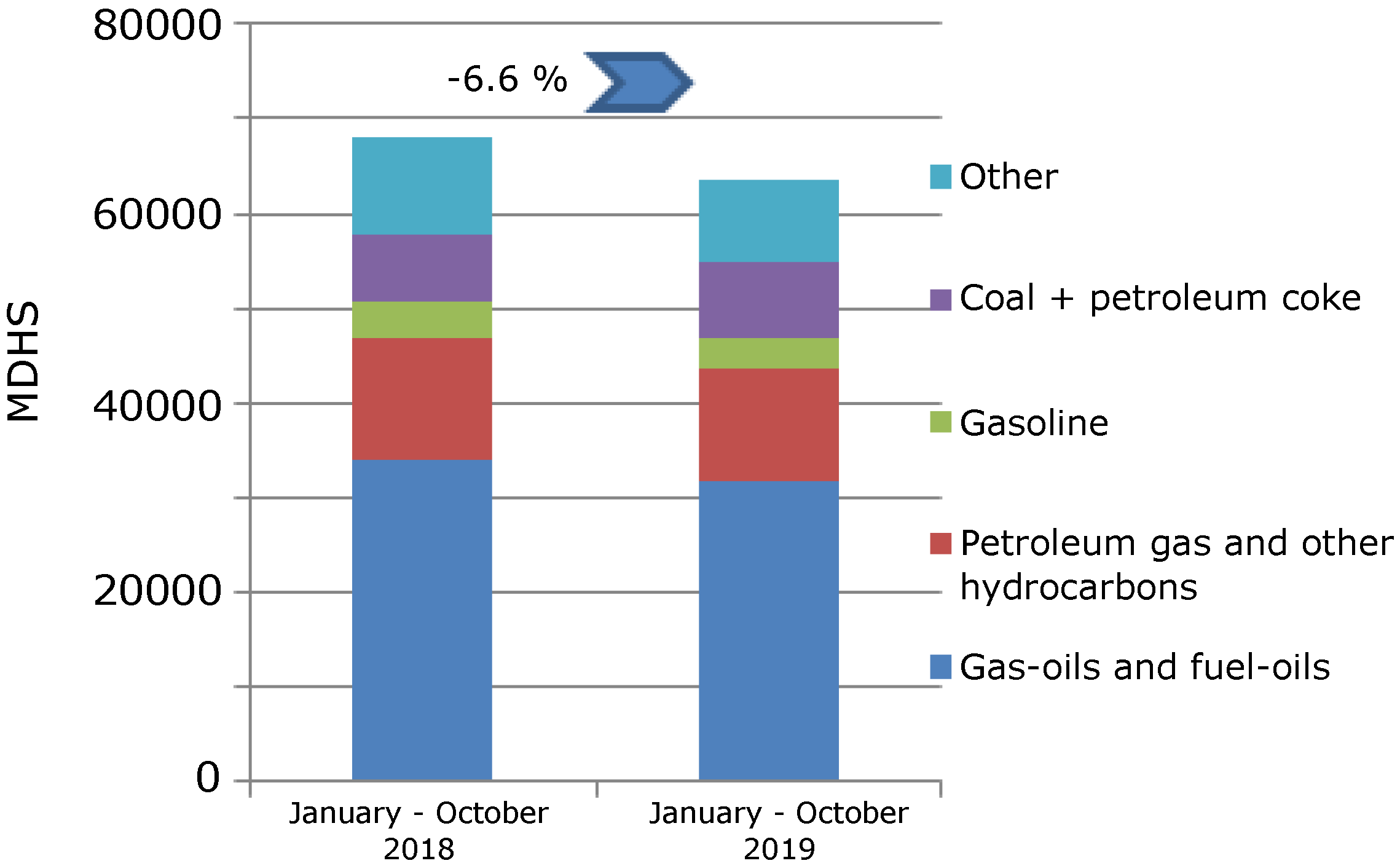
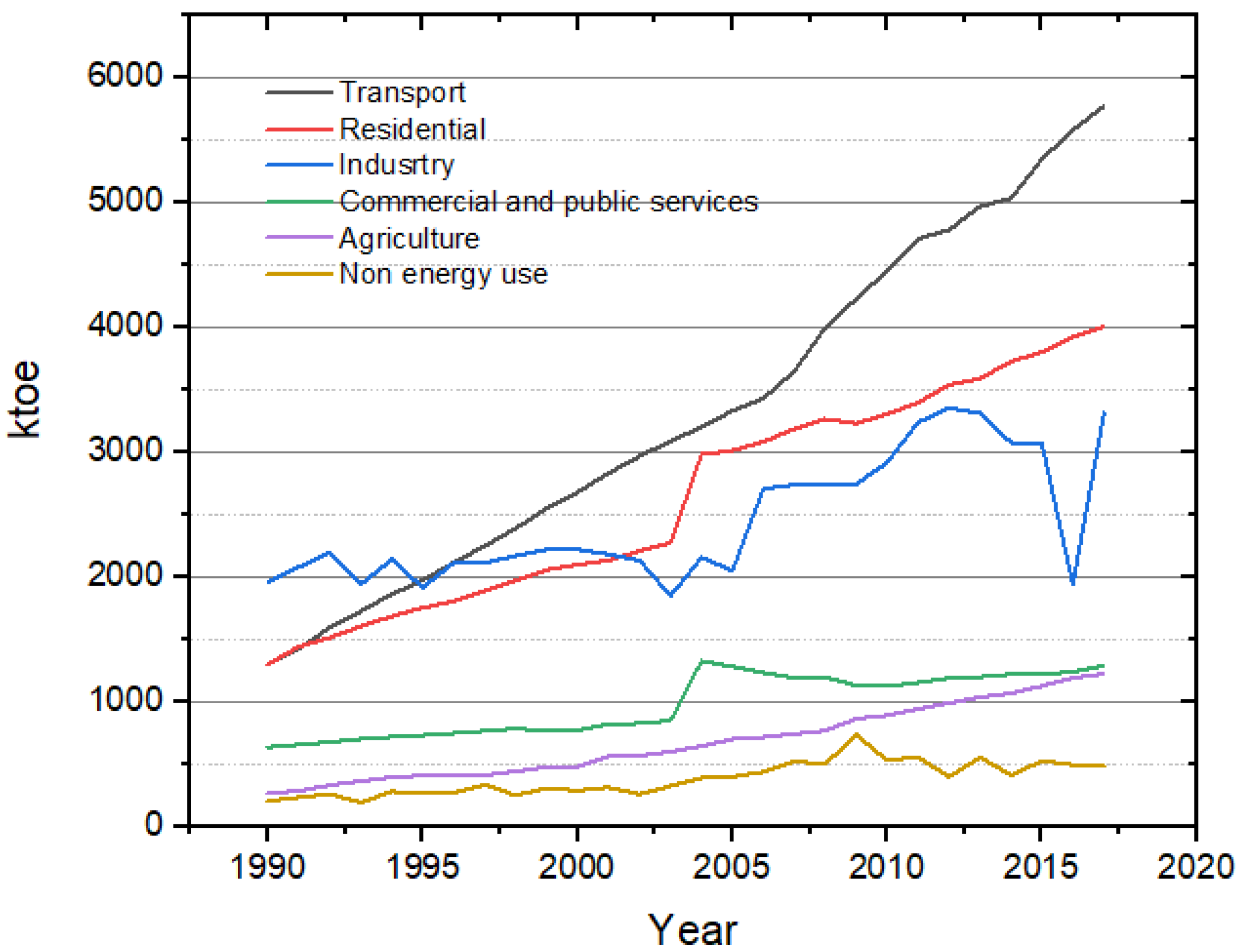

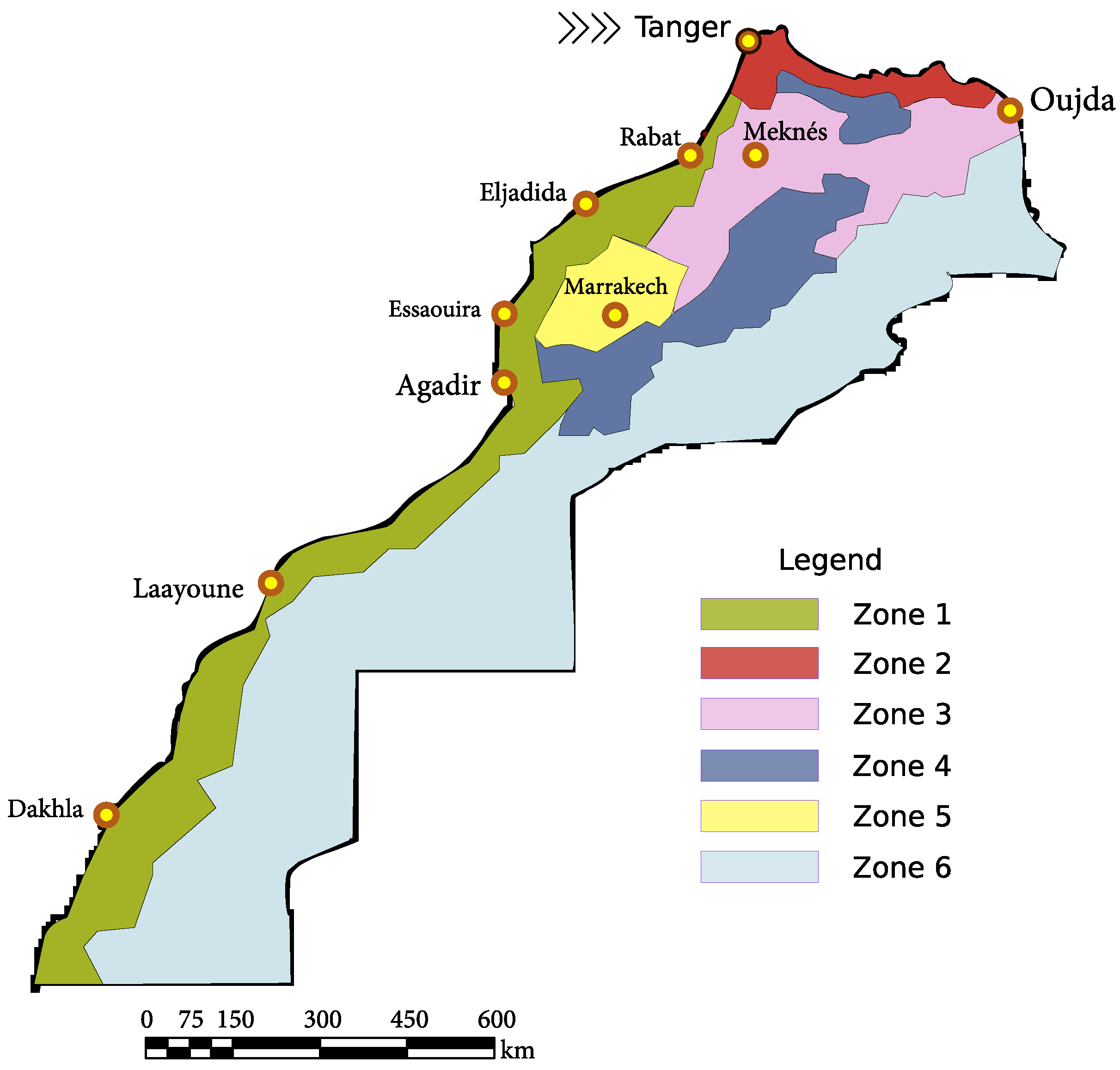
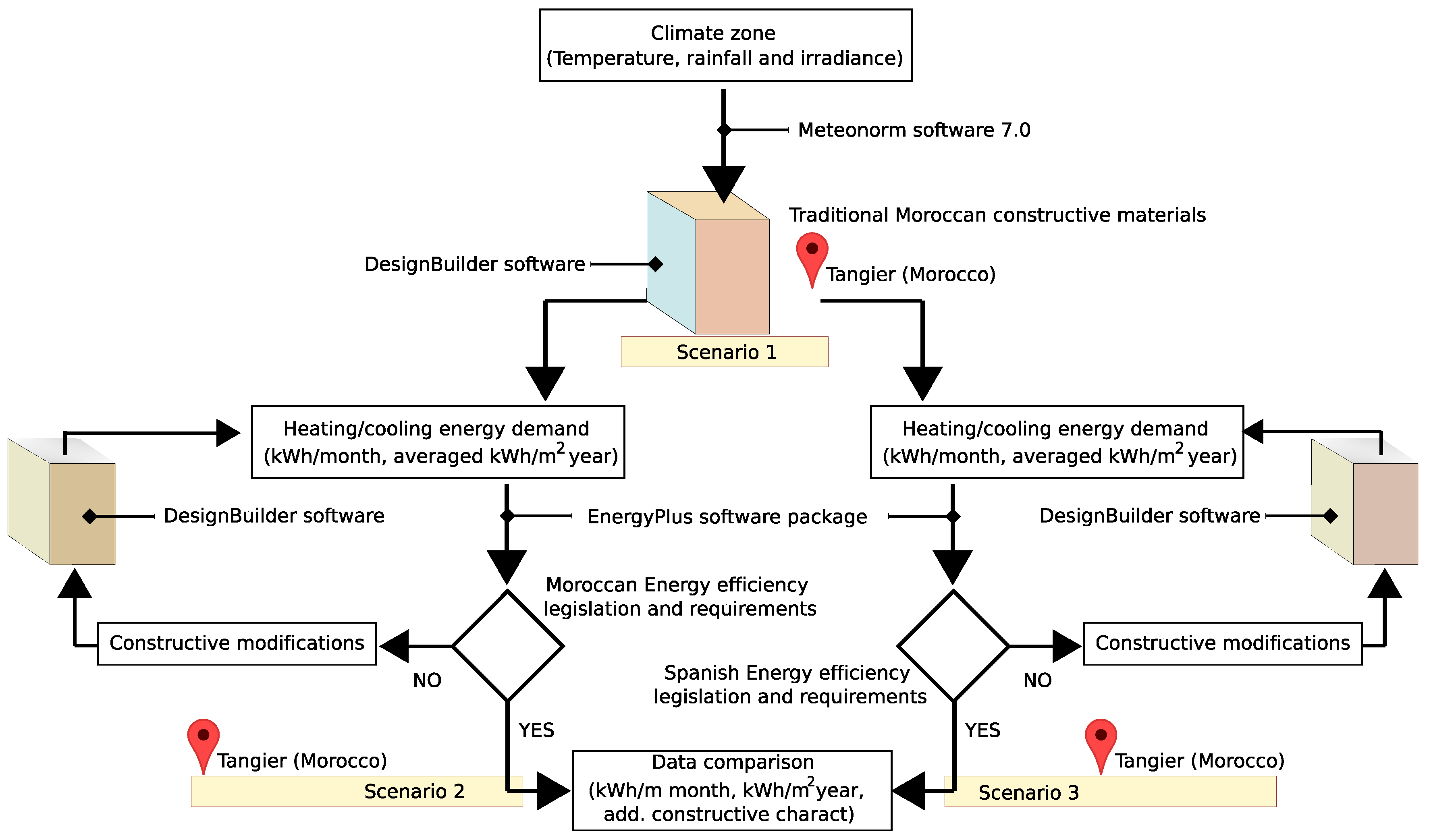
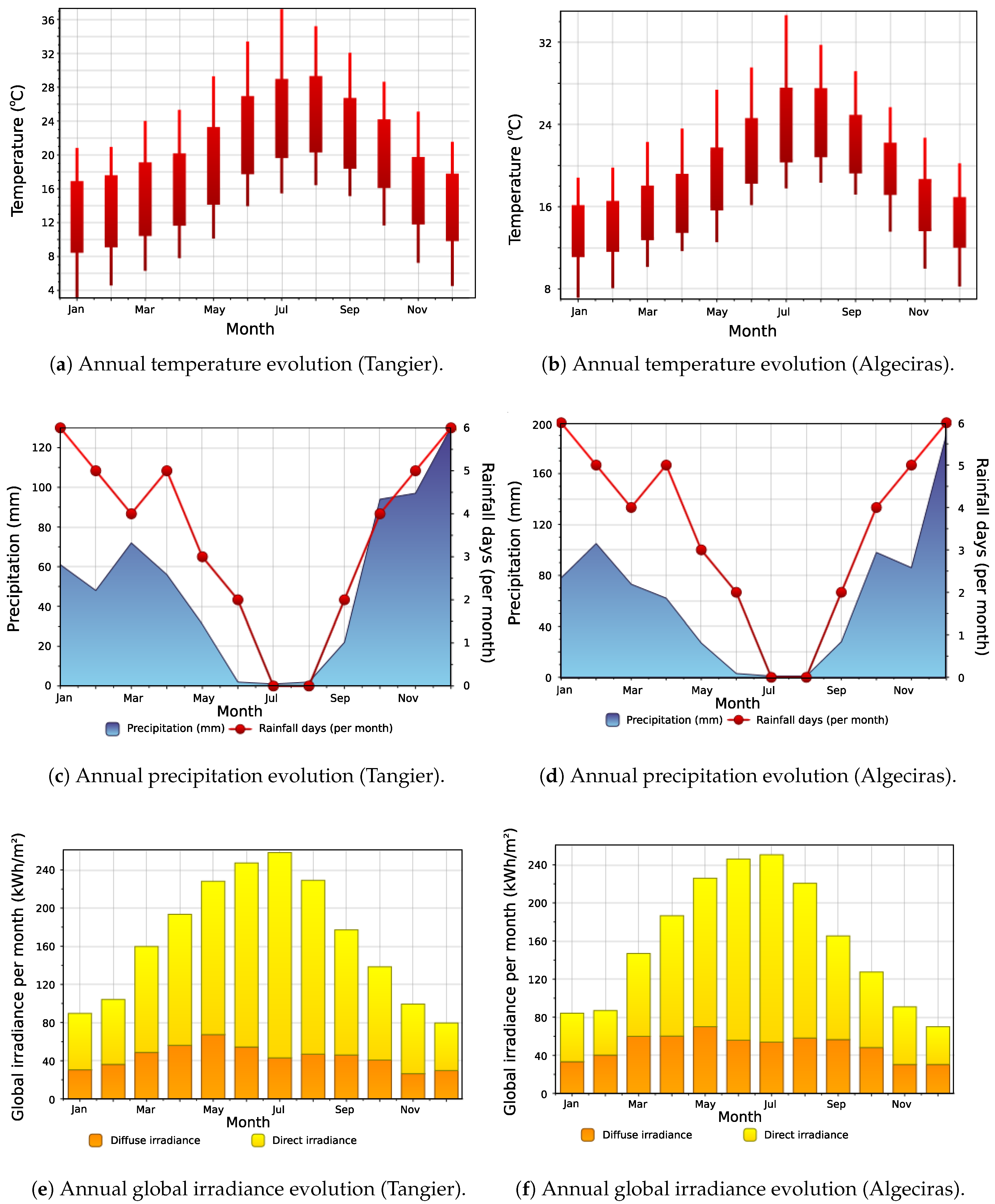
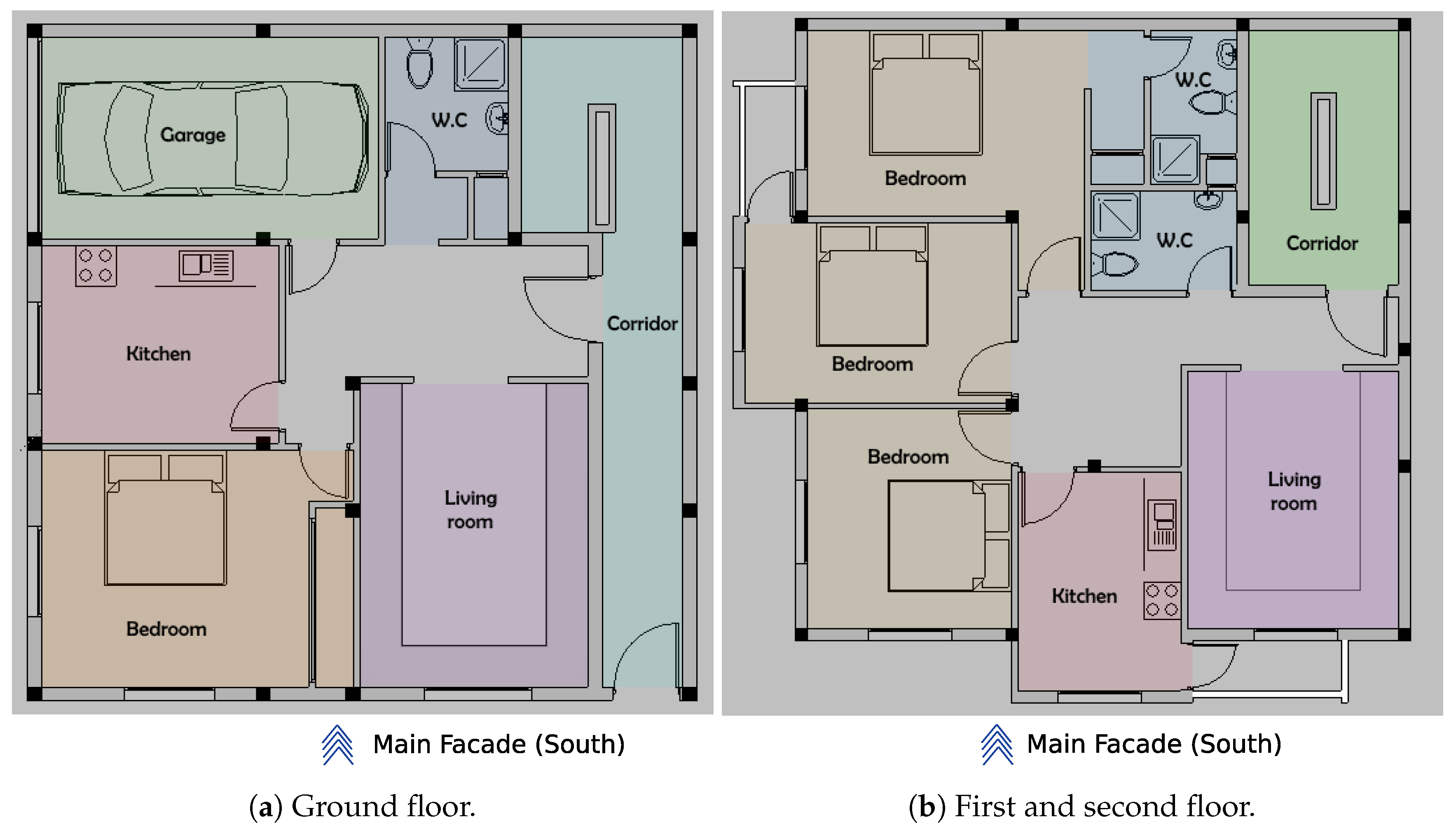
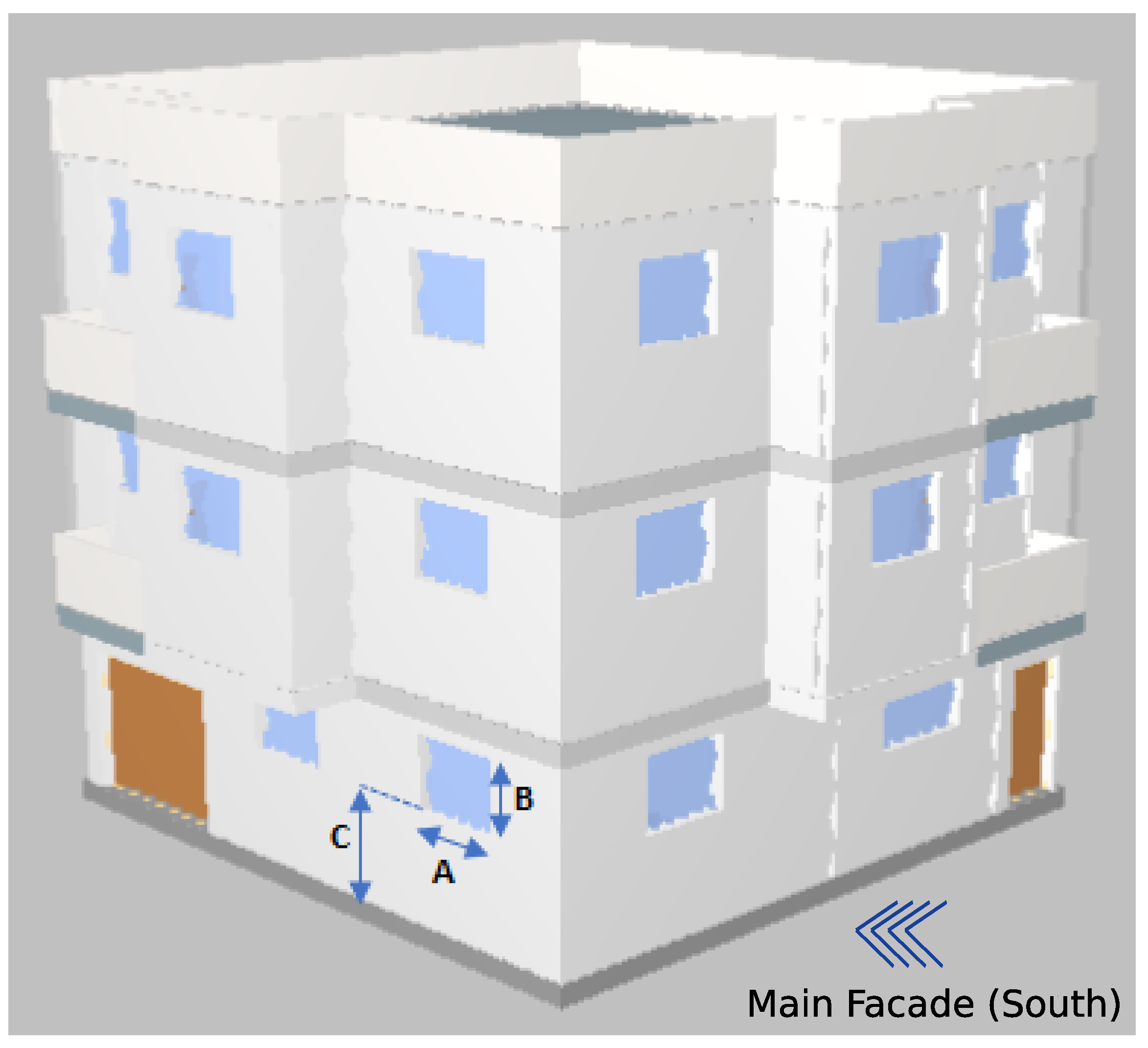

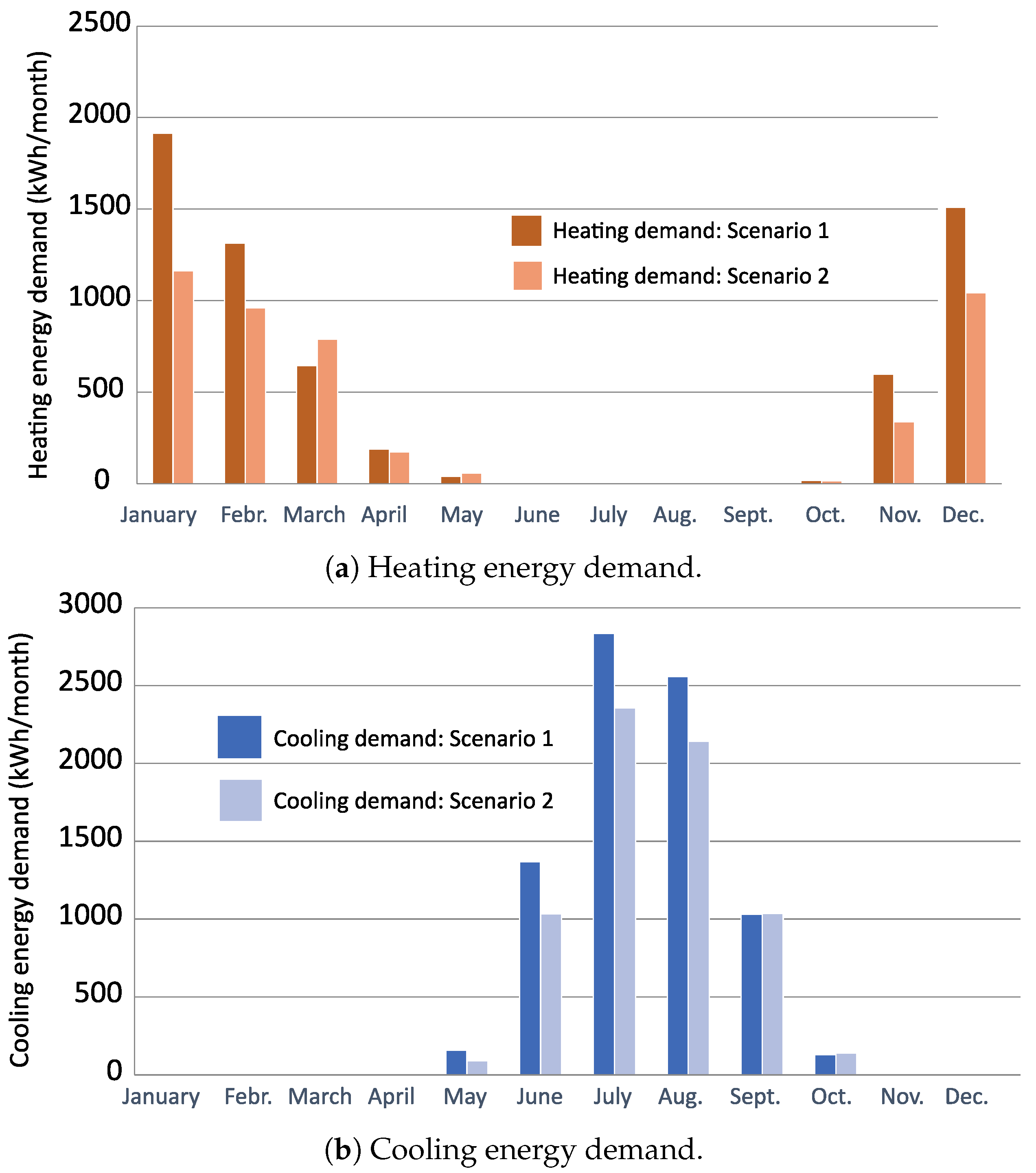
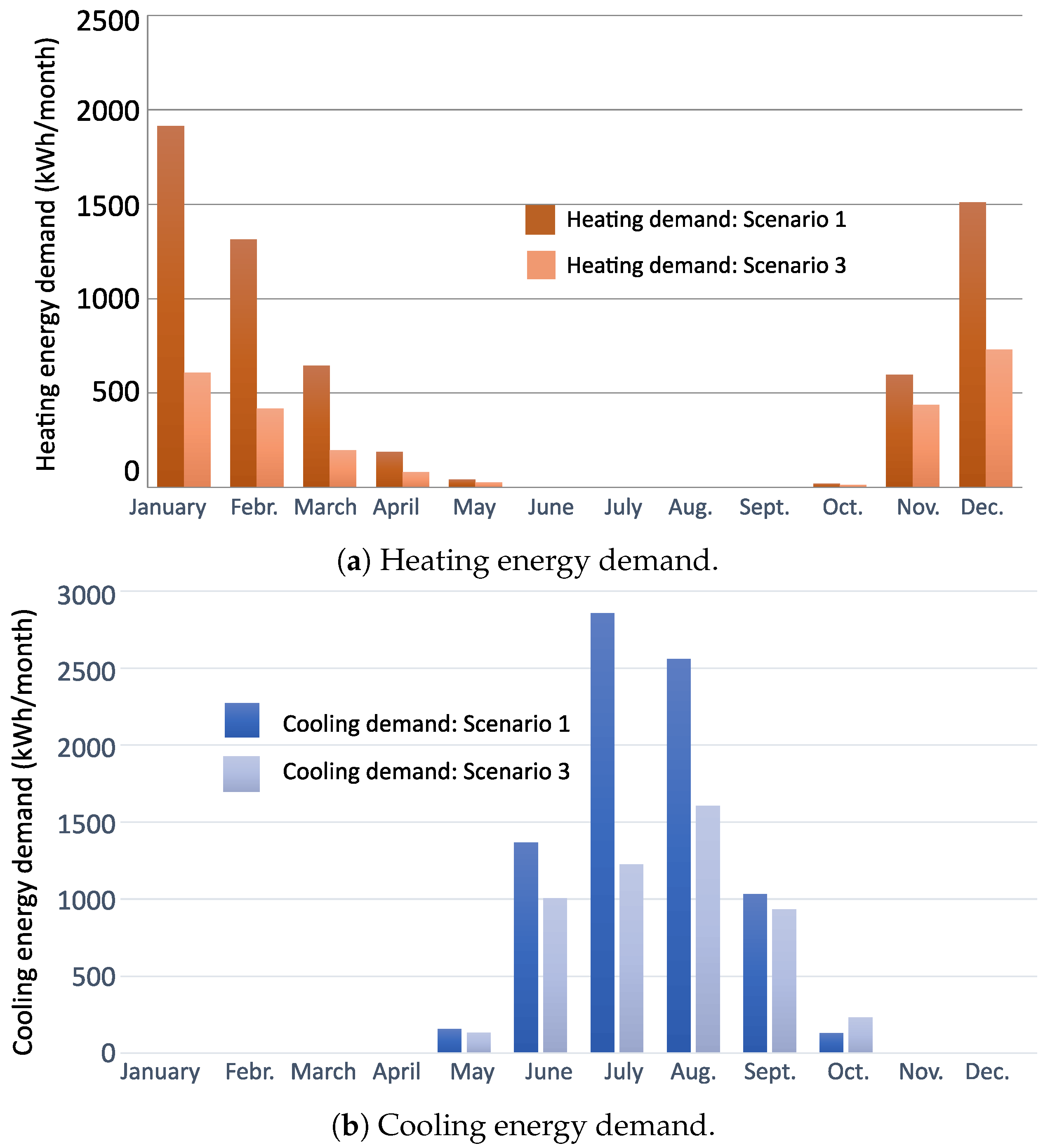

| Policy | Year | Status |
|---|---|---|
| Decree n. 927-20 on the compulsory application of Moroccan standards. | 2020 | In force |
| Photovoltaic products and solar thermal installations | ||
| Decree n. 2-17-746 on Mandatory energy audits and energy audit organisations | 2019 | In force |
| Energy efficiency program for public buildings | 2019 | In force |
| MEPS for Air Conditioners | 2018 | In force |
| Nationally Determined Contributions (NDC) | 2016 | In force |
| MorSEFE | 2015 | In force |
| Decree n. 2-13-874 on Thermal regulation of buildings | 2014 | In force |
| Moroccan Standard NM 14.2.300 | 2010 | In force |
| Country | Regulation | Energy Efficiency Criteria | Penalties | Incentives | |
|---|---|---|---|---|---|
| Design | Construction | ||||
| Spain | Technical Building Code (2019) | Yes | Yes | Yes | Yes |
| Morocco | Technical Building Code (2015) | Yes | No | No | No |
| Country | Heating/Cooling | Construction Methodology Details | Wall–Ceiling Insulation | Sealing & Ventilation | Lighting Efficiency | Window U–Value and Solar Factor | SHW | PV Integration |
|---|---|---|---|---|---|---|---|---|
| Spain | Yes | Yes | Yes | Yes | Yes | Yes | Yes | Yes |
| Morocco | No | Yes | Yes | No | No | Yes | No | No |
| Winter Climate Severity (WCS) | Summer Climate Severity (SCS) | ||
|---|---|---|---|
| A | WCS ≤ 0.30 | 1 | SCS ≤ 0.60 |
| B | 0.30 < WCS ≤ 0.60 | 2 | 0.60 < SCS ≤ 0.90 |
| C | 0.60 < WCS ≤ 0.95 | 3 | 0.90 < SCS ≤ 1.25 |
| D | 0.95 < WCS ≤ 1.30 | 4 | SCS > 1.25 |
| E | WCS > 1.30 | ||
| Material | Thickness (mm) | Thermal Conductivity (W/m · K) | (J/kg · K) | Density (kg/m3) | |
|---|---|---|---|---|---|
| External walls (1.2 W/m K) | cement plaster | 15 | 0.42 | 1000 | 1800 |
| brick wall | 70 | 0.34 | 1000 | 1800 | |
| air layer | 100 | 0.714 | 1012 | 1 | |
| brick wall | 70 | 0.34 | 1000 | 1800 | |
| cement plaster | 15 | 0.42 | 1000 | 1800 | |
| Roof (1.72 W/m K) | Tile | 7 | 1.40 | 1000 | 2500 |
| mortar layer | 15 | 0.42 | 1000 | 1800 | |
| reinforced concrete | 40 | 2.30 | 1000 | 2350 | |
| hollow block | 160 | 0.60 | 880 | 1000 | |
| cement plaster | 15 | 0.42 | 1000 | 1800 | |
| Intermediate floor | Tile | 7 | 1.40 | 1000 | 2500 |
| mortar layer | 15 | 0.42 | 1000 | 1800 | |
| reinforced concrete | 40 | 2.30 | 1000 | 2350 | |
| Glazing area | Simple glazing | U = 5.16 W/m K | |||
| Annual Cooling/Heating Energy Demand (kWh/year) | Averaged Cooling/Heating Energy Demand (kWh/m year) | |
|---|---|---|
| Heating demand | 6632 | 23.40 |
| Cooling demand | 8077 | 28.50 |
| Heating and cooling | 14,709 | 51.90 |
| Material | Thickness (mm) | Thermal Conductivity (W/m · K) | (J/kg · K) | Density (kg/m) | |
|---|---|---|---|---|---|
| External walls | Extruded polystyrene foam (XPS) | 20 | 0.026–0.035 | 1300–1700 | 30–50 |
| Roof | Extruded polystyrene foam (XPS) | 20 | 0.026–0.035 | 1300–1700 | 30–50 |
| Material | Thickness (mm) | Thermal conductivity (W/m · K) | (J/kg · K) | Density (kg / m) | |
|---|---|---|---|---|---|
| External walls | Extruded polystyrene foam (XPS) | 20 | 0.026–0.035 | 1300–1700 | 30–50 |
| Double-glazed glass | 4–12–4 | U = 2.90 W/m K | |||
| Roof | Extruded polystyrene foam (XPS) | 20 | 0.026–0.035 | 1300–1700 | 30–50 |
| Legislation | Annual Heating/Cooling | Reference Residential Building | |
|---|---|---|---|
| Demand Limit | Initial Design (Scenario 1) | Final Design | |
| Morocco RTCM (November 2015) | 46 kWh/m year | 51.9 kWh/m year | 42.61 kWh/m year (−17.9%, Scenario 2) |
| Spain DB-HE (June 2017) | 30 kWh/m year | 51.9 kWh/m year | 28.7 kWh/m year (−45.4%, Scenario 3) |
Publisher’s Note: MDPI stays neutral with regard to jurisdictional claims in published maps and institutional affiliations. |
© 2020 by the authors. Licensee MDPI, Basel, Switzerland. This article is an open access article distributed under the terms and conditions of the Creative Commons Attribution (CC BY) license (http://creativecommons.org/licenses/by/4.0/).
Share and Cite
Merini, I.; Molina-García, A.; García-Cascales, M.S.; Mahdaoui, M.; Ahachad, M. Analysis and Comparison of Energy Efficiency Code Requirements for Buildings: A Morocco–Spain Case Study. Energies 2020, 13, 5979. https://doi.org/10.3390/en13225979
Merini I, Molina-García A, García-Cascales MS, Mahdaoui M, Ahachad M. Analysis and Comparison of Energy Efficiency Code Requirements for Buildings: A Morocco–Spain Case Study. Energies. 2020; 13(22):5979. https://doi.org/10.3390/en13225979
Chicago/Turabian StyleMerini, Ikram, Angel Molina-García, M. Socorro García-Cascales, Mustapha Mahdaoui, and Mohamed Ahachad. 2020. "Analysis and Comparison of Energy Efficiency Code Requirements for Buildings: A Morocco–Spain Case Study" Energies 13, no. 22: 5979. https://doi.org/10.3390/en13225979
APA StyleMerini, I., Molina-García, A., García-Cascales, M. S., Mahdaoui, M., & Ahachad, M. (2020). Analysis and Comparison of Energy Efficiency Code Requirements for Buildings: A Morocco–Spain Case Study. Energies, 13(22), 5979. https://doi.org/10.3390/en13225979







